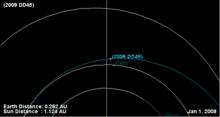2009 DD45
2009 DD45 is a small Apollo asteroid[1] that passed near Earth at an altitude of 63,500 km (39,500 mi) on 2 March 2009 at 13:44 UTC. It was discovered by Australian astronomers at the Siding Spring Observatory on 27 February 2009, only three days before its closest approach to the Earth.[2][3] Its estimated diameter is between 15 and 23 metres.[1] This is about the same size as a hypothetical object that could have caused the Tunguska event in 1908.[4]
| Discovery | |
|---|---|
| Discovery date | 27 February 2009 |
| Designations | |
| Orbital characteristics[1] | |
| Epoch 13 January 2016 (JD 2457400.5) | |
| Uncertainty parameter 2 | |
| Aphelion | 1.495206 AU (223.6796 Gm) |
| Perihelion | 0.98664198 AU (147.599539 Gm) |
| 1.240924 AU (185.6396 Gm) | |
| Eccentricity | 0.204913 |
| 1.38 yr (504.91 d) | |
Average orbital speed | 0.713018°/d |
| 338.8474° | |
| 0° 42m 46.781s / day | |
| Inclination | 13.74426° |
| 161.937243° | |
| 13.91345° | |
| Earth MOID | 0.000315545 AU (47,204.9 km) |
| Jupiter MOID | 3.47225 AU (519.441 Gm) |
| TJupiter | 5.122 |
| Physical characteristics | |
| Dimensions | 19±4 m (assumed)[1] |
| 1.2 h (0.050 d)[1] | |
| S[1] | |
| 25.8 | |

BBC News Online cites the minimum distance as 72,000 km (45,000 mi) (about 1/5 lunar distances).[4][5] 2009 DD45 passed farther away (40 thousand miles versus 4 thousand miles) but was substantially larger than 2004 FU162, a small asteroid about 6 m (20 ft) across which came within about 6,500 km (4,000 mi) in 2004,[4] and is more similar in size to 2004 FH. With an uncertainty parameter of 3, the asteroid is predicted to make its next close encounters with Earth on 29 February 2056 and 3 March 2067.[1]
References
- "JPL Small-Body Database Browser (2009 DD45)" (last obs. used 2009-03-06). Jet Propulsion Laboratory. Retrieved 11 April 2016.
- Kelly Beatty (1 March 2009). "Space Rock 2009 DD45 Buzzes Earth". Sky & Telescope. Archived from the original on 6 March 2009. Retrieved 4 March 2009.
- Victoria Jaggard (2 March 2009). "Surprise Asteroid Just Buzzed Earth". National Geographic Society. Archived from the original on 4 March 2009. Retrieved 4 March 2009.
- "Space rock makes close approach". BBC News Online. 3 March 2009. Archived from the original on 4 March 2009. Retrieved 3 March 2009.
- Scientific American, May 2009 issue, listed the minimum distance as 72,200 km (p. 26)
External links
- Universe Today article on 2009 DD45
- 100-meter asteroid will pass Earth Monday!, Phil Plait's Bad Astronomy blog
- NEO Asteroid 2009 DD45 from Canberra on YouTube
- 2009 DD45 at the JPL Small-Body Database
